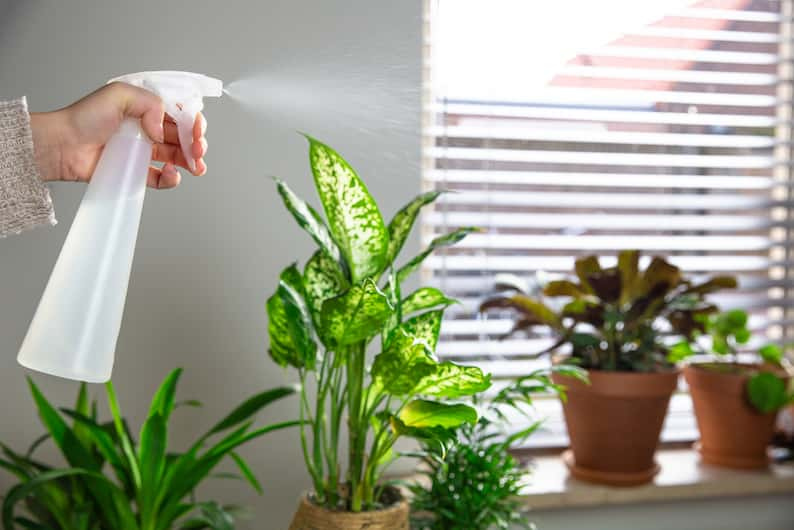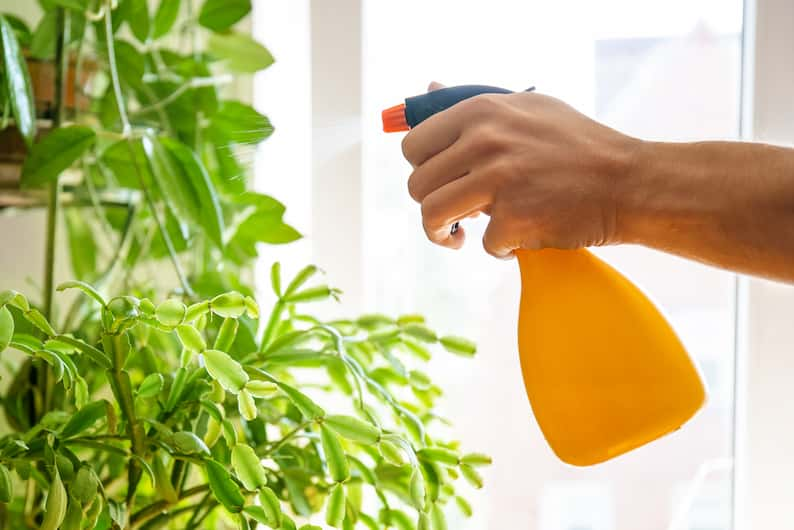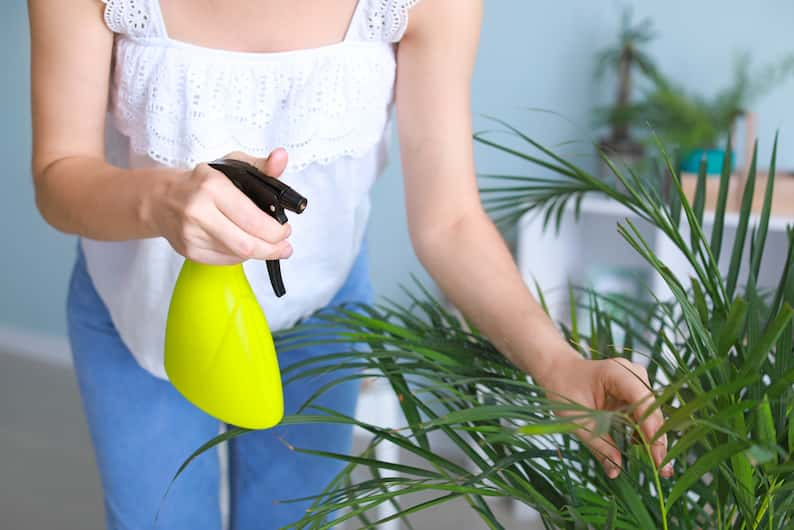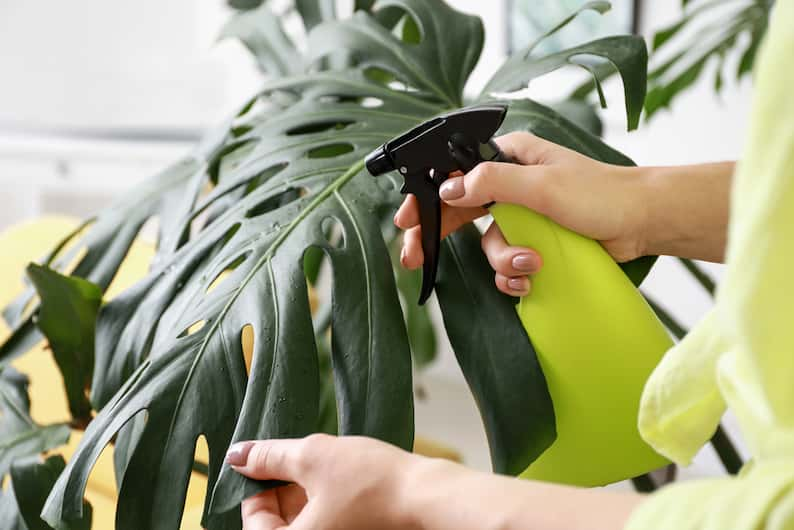The question of should you mist your indoor plants or not can provoke some pretty strong opinions from each side of the aisle.
Some argue that if you mist your houseplants, this can help them thrive, especially if they’re used to a more humid environment than the air in your home. Others, however, say that misting your houseplants is a complete waste of time that doesn’t have any real benefit for the plant.
So which is it? And if you do fall on Team Mist, which houseplants should be misted and when?
Keep reading to see just how to mist your plants, whether misting can benefit your houseplants – as well as you should even bother doing so.

Table of Contents
Should you mist your indoor plants?
Misting indoor plants definitely isn’t a bad thing to do, especially for those that come from tropical and subtropical regions and prefer higher humidity levels. However, it’s not strictly necessary to mist your plants given that there are more effective ways to boost humidity in your home.
Overall, though, it’s not bad to mist your plants, especially given how calming it can be for you. While, as mentioned, it’s best to focus this on tropical plants that thrive in higher humidity conditions, this doesn’t mean that non-tropical indoor plants shouldn’t be misted.
That said, there are definitely some that don’t need the extra moisture that misting gives them in order to survive. Some, in fact, will be healthier if you avoid misting them altogether.
And we’ll go through some examples of these below!
Spoiler alert: Keep reading to find out some of the other ways you may want to consider increasing humidity levels – which are actually considered more efficient than misting.
What do you need to mist your indoor plants?
Misting your indoor plants is a very simple process. In fact, all you need is the following:
- A spray bottle. If you don’t have one already, check out this fancy spray bottle to really help you feel like the lady or gentleman of the house.
- Lukewarm water. Some people say it’s better to use distilled water to mist your houseplants, but this is really only a major issue if you live in an area with hard tap water or other additives. If you’re really concerned, leave your tap water sitting for 24 hours to help chlorine and so on dissipate.
- Foliage cleaner and shiner (optional). You can also choose to use something like Miracle-Gro Leaf Shine. It helps hard leaves become stronger, making them look shinier and more vibrant, so it’s recommended as a great solution if your plants are looking spotty or dull.

Is misting good for plants?
Misting is good for many indoor plants as it’s a very quick and easy way to temporarily increase humidity, avoid overwatering and keep them looking green and fresh, especially if your houseplants’ leaves have been drooping a bit. It also helps to remove dust from your plant’s leaves.
In particular, if you don’t live in a tropical place and need a way to keep your indoor plants happy, misting your houseplants can be a good strategy. Given that these plants come from a more humid environment naturally, that’s definitely their preferred way to be.

And assuming that you can’t just up and move to the tropics for the benefit of your indoor plants (also a totally reasonable solution, of course), you’ll need to find a way to make your home as close as possible to what your plants are used to. Misting them is an incredibly cheap way to do this.
That said, it’s worth mentioning again: misting isn’t good for all indoor plants. Some don’t care at all but, for some, they really don’t like it.
Quick tip: A good rule of thumb is to simply consider where your plant comes from – the more tropical their home, the more misting is probably good for your indoor plant. There are exceptions though, as you’ll see below.
How can misting benefit your houseplants?
Misting benefits your houseplants by giving them the moisture they need to thrive that they would normally get from the humidity in the air in their natural environment. As the air in your home is probably drier than their natural habitat, misting helps your indoor plants’ leaves not to dry out.
In particular, misting your plants has the following benefits:
- Boosts humidity: As mentioned, misting your plants temporarily increases the amount of humidity around them.
- Helps to avoid overwatering: For many of us, as soon as we see our houseplants’ leaves start to droop, we rush to water them to stop them from dying. However, depending on the plant, this can often make the problem worse as many of them really don’t need as much water as you probably just gave them. Instead, by misting your houseplants, you’re giving them just the amount of moisture that they need to stay green and fresh – without drowning them.
- Deters spider mites: Another benefit of misting your indoor plants is that it can help you to avoid spider mite infestations. They love dry air so any moisture you add is going to be a great spider mite deterrent.
- Allows you to check for issues: Misting your houseplants gives you the chance to get up close and personal with your plants. You probably spend most of your day admiring them from afar, so having a few moments to check how they’re going could allow you to spot a problem before it gets out of hand.
- Removes dust from your plant’s leaves: A dusty leaf may not allow your plant to photosynthesize as effectively, so cleaning the leaves by misting can help your plant be as healthy as possible.
- Calming: It shouldn’t just be your plants getting all the advantages of misting. Taking the time out of your day to relax and give your plants a light spray has benefits for you too.
How often should you mist indoor plants?
You should mist your indoor plants one to two times per week, depending on how dry the air is where you are, how dry your plants look and how thin their leaves are. The thinner the leaves, the more frequently they’ll likely need to be misted.
It really only has to take a couple of minutes to do (depending on how big your plant collection is). Just spent a short time checking on each of your plants to see if their leaves are looking healthy or not. If you think they’re on the drier side, a quick spray could be all they need to thrive again.
When should you mist houseplants?
The best time to mist indoor plants is in the morning, as that prepares them for the day and ensures they’re able to dry out before the night.
That said, if you only remember to mist your houseplants later in the day, that’s not a major issue. Misting your indoor plants at night or even just in the afternoon won’t make or break them if it’s a one off, although do aim to do it earlier in the day in future to avoid them being too moist.
The bigger problem for most people is forgetting to mist (or, worse, water) them altogether, so you’re a step ahead if you’re simply remembering later in the day! However, it’s worth mentioning that this is another reason why you may want to consider other strategies to boost humidity besides misting – which I’ll get to shortly.

Should I mist my plants everyday?
Unless you live somewhere very dry, you likely don’t need to mist everyday. Instead, once or twice a week is usually enough. If you have plants though that need more humidity this consistently, consider another option for boosting the humidity such as adding a pebble tray.
Too much misting can actually harm a plant, especially if the leaves are staying too wet as it can promote rot and fungal growth. It’s also worth repeating that misting only offers a temporary solution as once the water evaporates, the humidity levels will also drop.
So if your plant looks dry which you think it’s due to the humidity being too low and occasional misting isn’t helping, consider some of the other options for increasing humidity levels that I’ll get to shortly.
How to mist plants
The best way to mist your indoor plants is as follows:
- Set a reminder once or twice a week to mist your houseplants in the morning.
- Fill a spray bottle with lukewarm water.
- Spray your plants lightly on both the top of the leaves and underneath them. The aim is to make them look like there’s some fine morning dew.
- Position your misted plants away from anywhere where they could be dried out too quickly, like a window, a heater or an air conditioner.
Does misting increase humidity?
Misting plants temporarily increases humidity around the plant, but won’t have much impact on the humidity in the rest of your home. The effect will also stop once the water that you’ve sprayed evaporates.
This is why misting works best on plants that come from a more humid environment, as this temporary increase of humidity mimics their natural habitat and helps them to thrive in your home.
That said, as mentioned, any increase of humidity from misting your plants is only temporary – and this is exactly why some people argue that misting is pointless.
My opinion: I wouldn’t go as far as saying that misting is completely pointless, as there are a number of benefits from misting, not all of which relate to humidity. However, if your main goal is to consistently increase humidity around your plants, the following tend to be more effective options compared to misting:
- Add a pebble tray
- Group your plants close together so there’s minimal air circulation between them
- Place a humidifier in the same room as your plants (although not right next to them). My preferred one – and the most popular one on Amazon, for what it’s worth – is below
- Move them to a more humid part of your home, like your bathroom.

Does spraying water on plant leaves help?
Spraying water on plant leaves by misting them can definitely help your plant thrive. It helps provide moisture to plants that like a more humid environment, can prevent certain bug infestations and also helps to remove any dust that may have settled on the plant’s leaves.
Just make sure that, as outlined above, you’re misting on both the top and underneath of each leaf. It’s also good to ensure you’re only misting with a light spray, as leaving your plant’s leaves wet for too long can encourage diseases to grow on your plant.
How do you mist plants without a spray bottle?
Misting plants without a spray bottle isn’t possible. In such cases, it’s best to consider other options to boost humidity levels around your plant besides misting. Options include adding a pebble tray, grouping your plants closer together or moving them to a more humid area in your house.
You’ll need some sort of item that forms a spray in order to mist your plants, so misting without a spray bottle won’t work. However, this isn’t a bad thing, especially if your main goal is to increase the humidity around your plant. This is because, as mentioned, the other options can actually be more efficient overall
It’s helpful though to revisit the fact that there are more benefits to misting than simply those relating to humidity. Keeping those in mind, maybe getting a cheap spray bottle so you can mist them isn’t the worst idea, even if it’s not strictly necessary.

What houseplants like to be misted?
In terms of which houseplants like to be misted, some examples include:
- African violet
- Aloe vera
- Arrowhead plant
- Banana plant
- Begonia
- Boston fern
- Bromeliads
- Caladium
- Calatheas
- Chinese evergreen
- Corn plant
- Croton
- Ctenanthe
- Dwarf umbrella tree
- Ferns
- Fiddle leaf figs
- Fittonia
- Indoor palms
- Laceleaf
- Lucky bamboo
- Majesty palm
- Money tree
- Monstera deliciosa
- Orchids
- Peace lily
- Philodendron
- Pilea
- Pothos
- Spider plant
- Zebra plant
Do peace lilies like to be misted?
Peace lilies do like to be misted from time to time. You can tell if you should mist your peace lily as it will start to noticeably droop slightly. That said, if your peace lily is drooping, check first whether it’s due to a lack of water rather than a humidity issue.
(It could also be a sign that your plant is getting too much light.)
This makes sense when you consider that the peace lily is native to southeast Asia and tropical regions of the Americas, areas that are both known for their humidity.
At the same time, peace lilies are one of the best houseplants as they only need to be watered about once a week. This means your extra bit of misting can be great for this plant – just don’t go overboard.
Should you mist succulents?
You shouldn’t mist fully grown succulents as they prefer to live in a drier environment. This means they don’t need the extra humidity that misting can bring which can, in fact, lead to rot or fungus.
You can, however, mist propagated baby succulents. These only need a little bit water to help them grow, so the light spray that comes when you mist your indoor plants is the perfect amount.
Do spider plants like to be misted?
Spider plants do like to be misted. However, they also generally need to be well watered, so make sure you’re not prioritizing misting your spider plants over watering them. This is because more issues can arise due to a snake plant that’s thirsty rather than one that needs higher humidity levels.
You should, however, reduce some of your watering in winter – although you’re fine to continue misting your spider plant as the temperature drops.
Should I mist my snake plant?
You shouldn’t mist your snake plant as their leaves are meant to always be kept dry. This means that if you mist it and make the leaves wet, this can lead to rot which can, ultimately, kill your snake plant.
In fact, the snake plant is one houseplant that really doesn’t need much water to thrive. The general advice is actually to only water it every two to six weeks, so you definitely don’t need to mist a plant that is as water averse as this one.
Should I mist my Monstera?
You should mist your Monstera if you want, given that they are a tropical plant, although it’s not necessary as they’re quite easy to look after. In terms of how often you should mist your Monstera, around once a week is fine.
It’s what makes the Monstera one of the most popular houseplants out there: the fact that it’s pretty difficult to kill one, which also extends to its simple watering needs. Just make sure you follow the general instructions above when misting it, such as only misting it in the morning and being careful of any nearby sources of dry air.

Should I mist my fiddle leaf fig?
You should mist your fiddle leaf fig to make sure it has enough humidity. As fiddle leaf figs are native to warm, tropical places, they enjoy living in a similar environment by having sufficient moisture around them to thrive, although make sure they don’t stay too wet.
Keeping both the leaves of fiddle leaf figs and its soil too moist can lead to the same problems outlined above, particularly including rot or pests. That said, given their preference for some moisture, it’s going to take quite a bit of leftover water or your fiddle leaf fig to have these kinds of issues.
Should you mist aloe vera?
You shouldn’t mist aloe vera as it prefers a dry environment. If you find yourself wanting to mist it because of dust, only do so every six to twelve months, avoid doing it in winter and try to use a gentle cloth instead, if you can.
In particular, while aloe vera is one of the hardiest houseplants around, it can be pretty susceptible to rot. This means that the best thing you can usually do for aloe vera is to simply leave it alone.
Should you mist a money tree?
Money trees love warm environments and humidity, so you should mist your money tree regularly to make sure that it has enough moisture. In fact, the money tree is one of the few plants where misting it even every day can be great for helping it to thrive.
The money tree is native to Central and South America, where it grows in swamps. This means that it loves a moist tropical area, so doing what you can to replicate this in your home is just what this plant wants.
Frequent misting can definitely help with this and some people even keep this plant in their bathrooms to make sure it has all the moisture it can have.
Should I mist my pothos?
You should not mist your pothos as it doesn’t need it. Instead, it actually prefers to be as dry as possible, with the general advice being not to water your pothos until the soil is completely dry and not to mist your pothos at all.
If you start to notice black spots forming on the leaves, be careful as it usually means that the soil hasn’t been able to dry enough – which can definitely be made worse by misting.
What plants should not be misted?
Most indoor plants are fine with being misted but there are some plants that should not be misted, mainly because they don’t need a lot of moisture to survive. These include:
- African violet
- Cacti
- Cissus
- Dragon tree
- Piggyback plants
- Ponytail plant
- Pothos
- Snake plants
- Stromanthe
- Succulents
- Velvet Calathea
- Yucca
In brief: Essentially, any plant that prefers dry air doesn’t need to be misted. You should also stay away from misting any plant with hairy leaves, as the moisture can get trapped in the “fuzz”, which can result in bugs or rotting leaves.
Can you water plants with a spray bottle?
As soil needs enough water for the plant’s roots to absorb as much as they need, watering plants with a spray bottle likely won’t provide enough water for the plant to survive. In addition, misting involves spraying leaves whereas watering is done at soil level.
This is why we’d only recommend misting your plants with a bottle, not watering them entirely. Misting isn’t meant to be a replacement for watering your plants.
After all, remember that, in general, you’re misting plants for humidity. That is, the main problem it’s solving is the lack of humidity in your air for plants that are used to more humid environments. This means that not all plants actually need to be misted
In almost all cases though, plants do need to be watered. This shows that each action isn’t a replacement for the other one, given that they address different issues.
Final thoughts on misting houseplants
As you can see, the answer to the question of should you mist your indoor plants is: it depends.
There’s no way to say definitively whether misting plans is good or bad. For instance, some plants really should not be misted because it’s either simply not needed or, worst case scenario, these few little sprays can actually kill them.
Misting can benefit your houseplants though in many cases, especially if you have plants that originally come from a more tropical environment so love a bit of humidity in the air. In those cases, it’s a good idea to mist your indoor plants from time to time to help them feel at home.
And if you’re not sure whether your specific houseplant likes to be misted or not, remember the rule of thumb: no misting succulents or fuzzy leaved plants. Other than that, you’ll mostly be fine – but if you need peace of mind, your local gardening center can definitely clarify for you.
